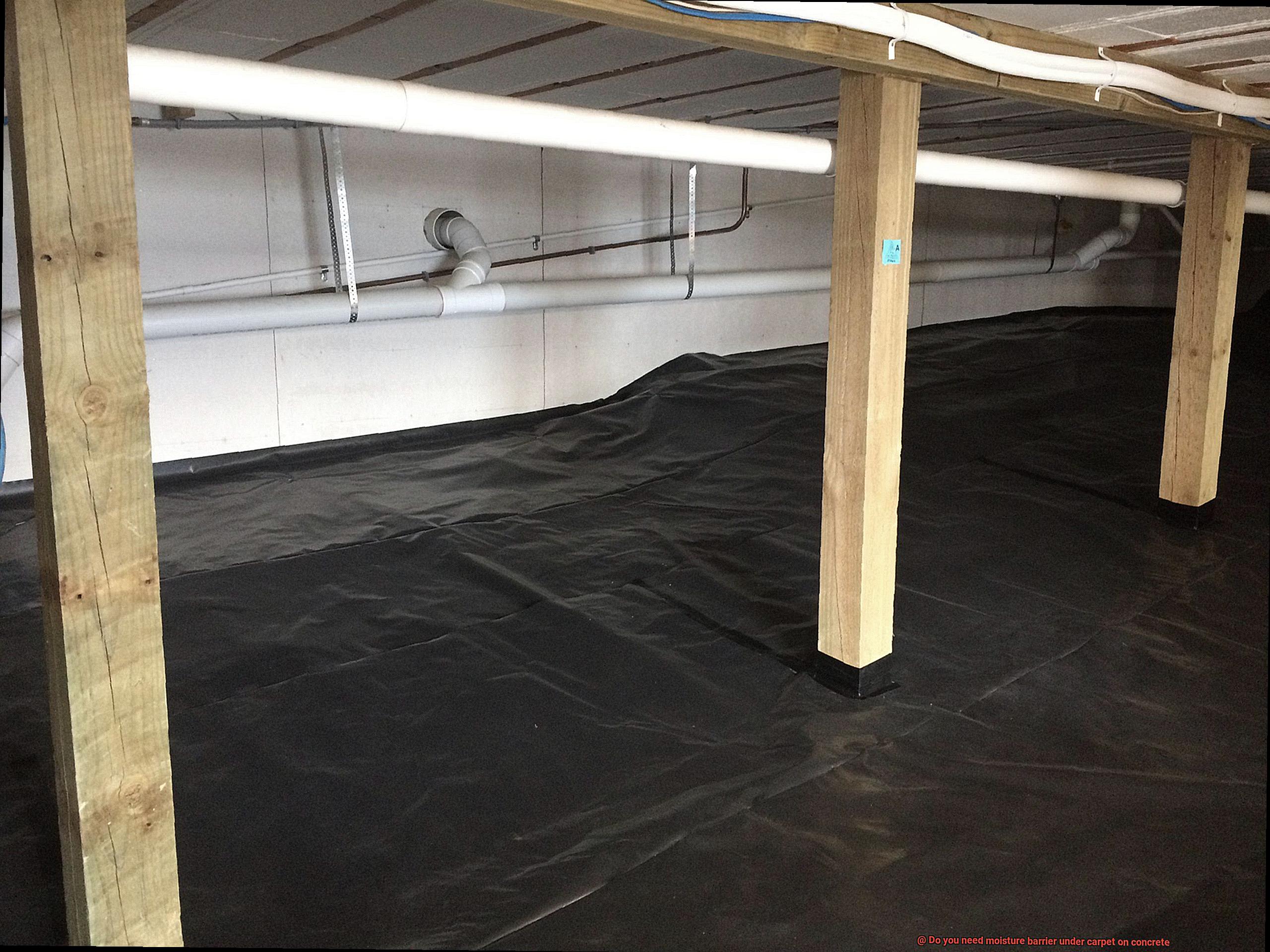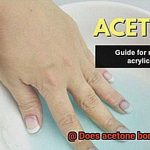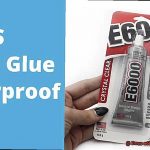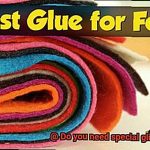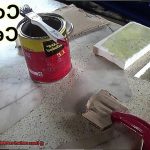Hey there, homeowners and renters. Sick of dealing with pesky mold growth, funky odors, and damaged floors caused by moisture seeping through your concrete slab? Well, you’re not alone. But fear not, because installing a moisture barrier under your carpet on concrete may just be the solution you need.
Now, you might be thinking: “But wait, isn’t concrete supposed to be solid and impenetrable?” While it may seem that way at first glance, concrete is actually quite porous. It can easily absorb moisture from the ground and slowly release it into your home – causing all sorts of headaches. But don’t worry – a moisture barrier can save the day.
A moisture barrier can come in various forms – think plastic sheeting or specialized coatings that seal the concrete and prevent any unwanted moisture from penetrating it. By eliminating the excess dampness, you’ll effectively create a healthier living environment while also extending the lifespan of your carpet.
Of course, before diving headfirst into installing a moisture barrier, it’s important to understand your home’s humidity levels, what type of carpet you have, and the overall condition of your concrete slab. This will ensure that you choose the right material for maximum protection.
So, if you’re ready to learn everything there is to know about moisture barriers under carpet on concrete – from benefits to materials to installation processes – then buckle up and get ready for an informative ride.
What is a Moisture Barrier?
Contents
- 1 What is a Moisture Barrier?
- 2 Why Do You Need a Moisture Barrier Under Carpet on Concrete?
- 3 Types of Moisture Barriers for Concrete Subfloors
- 4 Benefits of Installing a Moisture Barrier Under Carpet on Concrete
- 5 Factors to Consider When Choosing a Moisture Barrier
- 6 How to Install a Moisture Barrier Under Carpet on Concrete
- 7 Cost of Installing a Moisture Barrier Under Carpet on Concrete
- 8 Common Mistakes When Installing a Moisture Barrier
- 9 Conclusion
A moisture barrier is a critical component of any construction project involving concrete subfloors and flooring materials. It serves as a protective layer between the concrete slab and any flooring materials that will be installed on top of it, such as carpet, hardwood or tile.
Moisture barriers come in various forms, including plastic sheeting, asphalt felt, and specialized coatings. The type of barrier you choose depends on several factors such as the level of moisture in the concrete, the type of flooring material being installed and the overall climate and humidity levels in your area.
One popular option is a plastic vapor barrier. It’s easy to install and relatively inexpensive. It consists of a sheet of plastic placed between the concrete and the flooring material. Another option is a liquid-applied moisture barrier, which provides an extra layer of protection against moisture and can be particularly effective in high-moisture areas or in situations where water damage has already occurred.
The purpose of a moisture barrier is to prevent moisture from seeping up through the concrete slab and into the flooring materials. This can lead to a range of problems such as mold growth, warping, and decay. By acting as a protective layer, a moisture barrier keeps the flooring materials safe from moisture damage.
It’s important to note that not all concrete slabs require a moisture barrier. A professional contractor can assess the site and determine whether a moisture barrier is necessary for your project based on factors such as climate, soil type, and water table.
Skipping the moisture barrier step when installing flooring materials on a concrete subfloor may seem like a cost-saving measure, but it can lead to costly damage down the line. Investing in a quality moisture barrier can help ensure that your flooring stays looking and performing its best for years to come.
Why Do You Need a Moisture Barrier Under Carpet on Concrete?
If you’re planning to install carpet over a concrete subfloor, you might be wondering if a moisture barrier is really necessary. Well, the short answer is yes – and we’re here to tell you why.
First and foremost, using a moisture barrier under carpet on concrete can help prevent the growth of mold and mildew. Concrete is a porous material that can easily absorb moisture, and if left unprotected, this moisture can seep up into your carpet and padding, creating the perfect breeding ground for these harmful substances.
Not only can mold and mildew be unsightly, but they can also pose serious health risks. By investing in a moisture barrier, you can help ensure that your indoor air quality remains safe and healthy for you and your family.
But that’s not all – a moisture barrier can also help prevent unpleasant odors from developing in your carpet. Moisture trapped in the fibers and padding can lead to musty or unpleasant smells that are difficult to get rid of. By using a moisture barrier, you can nip this issue in the bud before it even has a chance to develop.
In addition to protecting your health and preventing odors, a moisture barrier can also help preserve the integrity of your carpet adhesive. Moisture can weaken the glue over time, causing your carpet to become loose or even detach from the concrete subfloor altogether.
And last but certainly not least, using a moisture barrier can extend the life of your carpet. By preventing moisture from damaging the fibers and padding, you’ll be able to enjoy your investment for years to come.
Types of Moisture Barriers for Concrete Subfloors
Installing carpet on a concrete subfloor can be a daunting task, especially if moisture is present. Moisture can seep through the concrete and cause damage to the carpet, padding, and subfloor. Luckily, there are several types of moisture barriers available to prevent this from happening.
Film Barriers
A popular option is a film barrier. It’s a thin layer of plastic made of polyethylene that is placed over the concrete subfloor before the carpet pad and carpet are installed. This type of barrier is easy to install, making it a common choice among homeowners.
Liquid-Applied Barrier
Another type of moisture barrier is a liquid-applied barrier. It’s a coating applied directly to the concrete subfloor using a trowel or roller, creating a seamless layer that provides excellent protection against moisture. Although more expensive than film barriers, it can be used in areas with high levels of moisture.
Asphaltic Felt Paper

Asphaltic felt paper is another common type of moisture barrier for concrete subfloors. It’s laid down over the concrete subfloor and provides a barrier against moisture. However, it should only be used in dry areas with low levels of moisture.
Composite Moisture Barriers
Composite moisture barriers combine layers of different materials to provide superior protection against moisture for concrete subfloors. Although more expensive than other types, they offer excellent protection and durability.
Recycled Materials
For an eco-friendly option, recycled materials such as plastic or paper can be used as moisture barriers for concrete subfloors. These types of barriers can provide effective protection against moisture while being environmentally conscious.
Benefits of Installing a Moisture Barrier Under Carpet on Concrete
If you’re considering installing carpet on a concrete subfloor, it’s crucial to think about using a moisture barrier. A moisture barrier is a layer of material that acts as a shield between the concrete and carpet padding. By preventing moisture from seeping into the carpet, it can prevent mold, mildew, and musty odors from forming. Here are some reasons why you should consider installing a moisture barrier under carpet on concrete.
Protection Against Moisture Damage
Concrete is porous and can absorb moisture from the ground or surrounding environment. When this happens, the moisture can seep into the carpet, causing mold, mildew, and unpleasant odors. By installing a moisture barrier, you can prevent this from happening, ensuring your carpet remains dry and free from harmful molds and odors.
Prolongs Carpet Lifespan
Moisture weakens the adhesive used to attach the carpet to the floor. This can lead to delamination and premature wear and tear of your carpet. However, by using a moisture barrier, you can protect the adhesive and prolong your carpet’s lifespan. This means you won’t have to replace your carpet frequently, saving you money in the long run.
Improves Indoor Air Quality
Mold and mildew release spores into the air, which can trigger allergies and respiratory problems. By preventing these contaminants from growing in your carpet, you can maintain a healthier indoor environment for you and your family. A moisture barrier keeps your carpet safe from moisture damage and helps improve indoor air quality.
Various Types of Moisture Barriers Available
There are different types of moisture barriers available, such as film barriers, liquid-applied barriers, asphaltic felt paper, composite moisture barriers, and eco-friendly options like recycled materials that provide excellent protection against moisture damage.
Factors to Consider When Choosing a Moisture Barrier
The best way to protect your investment and ensure a healthy indoor environment is by choosing the right moisture barrier. But with so many options available, how do you know which one is right for you? As an expert in this field, I have compiled some factors to consider when choosing a moisture barrier for your carpet on concrete.
First and foremost, determining the level of moisture present in your concrete subfloor is crucial. You can consult with a professional flooring contractor or use a simple moisture meter test to determine the moisture level. This information will help you select a moisture barrier that is appropriate for your specific situation.
Secondly, there are several types of moisture barriers available, including sheet membranes, liquid-applied membranes, and epoxy coatings. Each has its advantages and disadvantages, so it’s vital to weigh your options carefully before making a decision. Consider factors such as ease of installation, durability, and compatibility with your carpet and adhesive.
Thirdly, the installation method and compatibility with your carpet and adhesive are important considerations. Some moisture barriers require additional adhesives or primers, while others may not be suitable for certain types of carpet or adhesive. It’s essential to select a moisture barrier that is compatible with your specific installation requirements to ensure a successful and long-lasting outcome.
Finally, consider the cost and durability of the moisture barrier. While some products may be more expensive initially, they may offer better long-term protection against moisture damage and prolong the life of your carpet. Don’t just focus on the initial cost; instead, consider the overall value of the product.
How to Install a Moisture Barrier Under Carpet on Concrete
Installing a moisture barrier under carpet on concrete is not only crucial to safeguard your investment but also to ensure that you and your family are breathing in healthy air. Concrete has the ability to absorb moisture, which can lead to mold and mildew growth, and cause unpleasant odor and health problems. Here’s a detailed guide on how to install a moisture barrier under carpet on concrete.
Step 1: Clean the Concrete Surface
Before starting the installation process, it’s important to clean the concrete surface thoroughly. Use a broom or vacuum to remove any dirt, debris, or other substances that may interfere with the moisture barrier’s adhesion. Ensure that the surface is completely dry before moving on to the next step.
Step 2: Measure and Cut the Moisture Barrier Material
Measure the area of the room where you will be installing the barrier and cut the moisture barrier material to size. We recommend leaving an extra 6-8 inches along each edge to overlap and seal. This will provide complete coverage for the entire concrete surface.
Step 3: Lay the Moisture Barrier Flat
Lay the moisture barrier flat on the concrete surface, starting at one end of the room and working your way towards the other end. Make sure that there are no wrinkles or creases in the material. Overlap any seams by at least 6 inches, and tape them together using moisture-resistant tape.
Step 4: Secure the Moisture Barrier in Place
Secure the moisture barrier in place using a strong adhesive or double-sided tape, making sure to cover all edges and seams. Leave no gaps or openings as this can allow moisture to seep through. Use a staple gun to secure it in place, making sure that it’s taut and flat.
Step 5: Allow Drying Time
Allow the adhesive to dry fully before installing carpet over the moisture barrier. This will ensure that your carpet stays looking and performing its best for years to come. Follow the carpet manufacturer’s instructions for installation.
Cost of Installing a Moisture Barrier Under Carpet on Concrete
As an expert in this field, I have compiled research to help you understand the cost associated with installing a moisture barrier under carpet on concrete.
The cost of installation depends on several factors such as the size of the area, type of moisture barrier, and labor costs. The cost of a basic plastic sheeting moisture barrier can be as low as $0.15 per square foot, while a more advanced vapor barrier can range from $0.80 to $2.00 per square foot. Additionally, labor costs vary depending on the size of the area and can range from $1 to $3 per square foot.
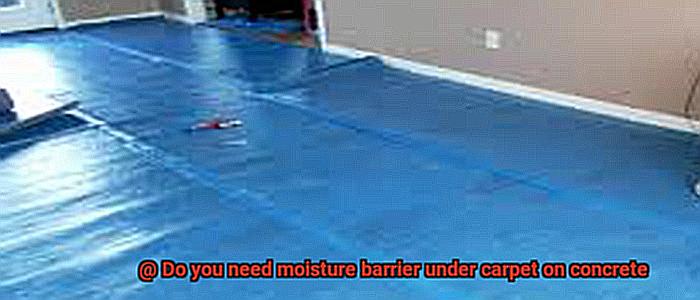
While the cost of installation may seem daunting, it is important to consider the long-term benefits. By preventing moisture from damaging your carpet, you can potentially avoid costly repairs or replacements in the future.
One crucial factor to consider is whether to hire a professional installer or attempt a DIY project. While DIY may seem like a cheaper option upfront, it could end up costing more in the long run if mistakes are made during installation. Professional installers have access to specialized equipment and materials that ensure proper installation, saving you time and money in the future.
Common Mistakes When Installing a Moisture Barrier
These mistakes can lead to costly damages and even health hazards. It’s important to be aware of these common mistakes to ensure a successful installation.
Mistake #1: Improper Surface Preparation
The first mistake people make is not properly preparing the concrete surface before installing the moisture barrier. This is a crucial step that must not be overlooked. Cleaning and thoroughly drying the surface are essential before laying down any type of moisture barrier. Any dirt, debris or moisture left behind can compromise the effectiveness of the moisture barrier.
Mistake #2: Using the Wrong Type of Moisture Barrier
Another common mistake is using the wrong type of moisture barrier. There are different types of moisture barriers designed for different environments, and using the wrong one can lead to moisture problems down the road. Be sure to choose a moisture barrier that is appropriate for your specific needs.
Mistake #3: Improper Installation
Improper installation is another common mistake when it comes to installing a moisture barrier under carpet on concrete. It’s essential to follow the manufacturer’s instructions carefully and use specialized equipment and materials to ensure proper installation. Cutting corners or skipping steps can lead to costly mistakes in the long run.
Mistake #4: Failing to Seal Edges
Finally, failing to seal the edges of the moisture barrier is a common mistake that can lead to water seeping through and causing mold or mildew growth. Be sure to seal all edges with a waterproof tape or adhesive to prevent this from happening.
In addition to these common mistakes, there are other factors to consider when installing a moisture barrier. Here are some useful tips:
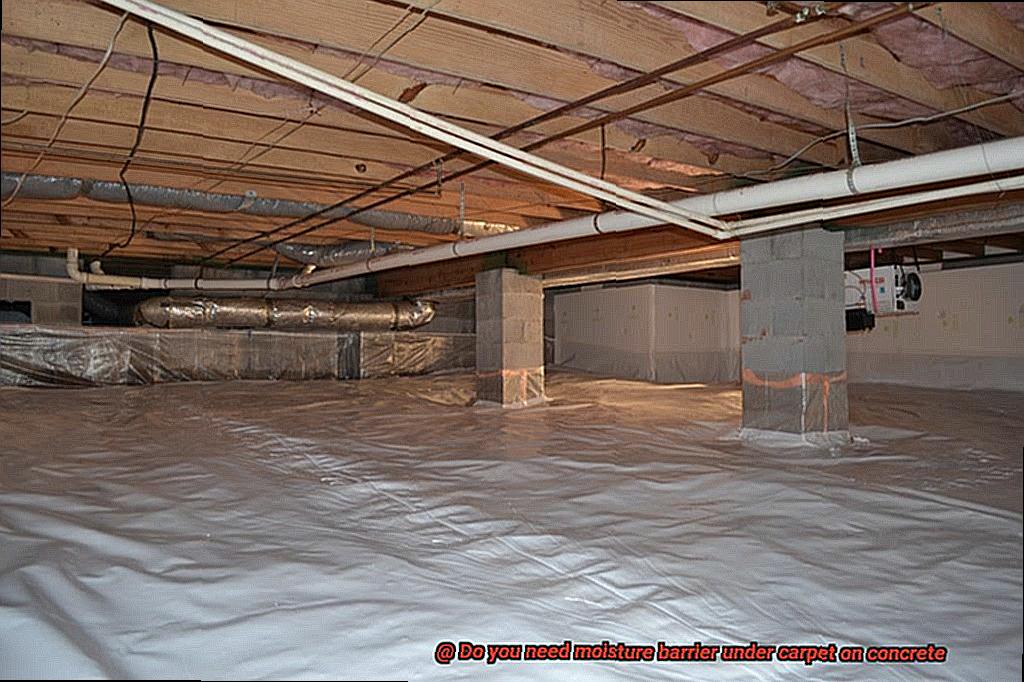
- Check for existing moisture issues before installing a moisture barrier.
- Use a professional-grade moisture meter to ensure proper levels.
- Allow enough time for the concrete surface to dry completely before installing the moisture barrier.
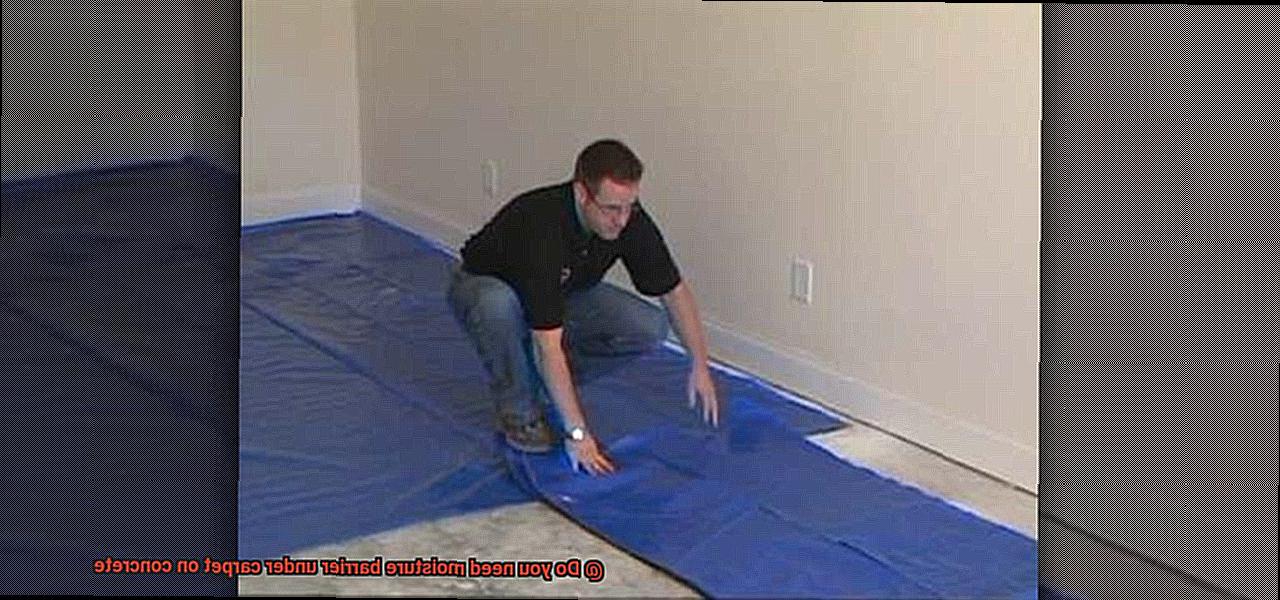
IiDOtC3Tibk” >
Conclusion
In conclusion, it’s clear that installing a moisture barrier under carpet on concrete is not just important, but essential. Without one, you risk the growth of mold and mildew, which can pose serious health risks and damage your flooring materials. But with the right moisture barrier in place, you can protect both your health and your investment.
Concrete is porous by nature, which means that moisture can seep through and cause damage to any flooring materials installed on top of it. A moisture barrier acts as a protective layer between the concrete slab and your carpet, preventing any unwanted moisture from penetrating through.
There are several different types of moisture barriers available to choose from, such as plastic sheeting, asphalt felt paper, specialized coatings, composite moisture barriers, and eco-friendly options made from recycled materials. When selecting a moisture barrier for your project, it’s crucial to consider factors like the level of moisture in the concrete, the type of flooring material being installed, and the climate and humidity levels in your area.
Proper surface preparation is key when installing a moisture barrier under carpet on concrete. You must use the right type of barrier for your specific installation requirements and follow proper installation techniques to avoid costly mistakes down the road.
While investing in a quality moisture barrier may seem like an added expense at first glance, it’s worth every penny. Not only will it help ensure that your flooring stays looking and performing its best for years to come but also promote healthy indoor air quality.

